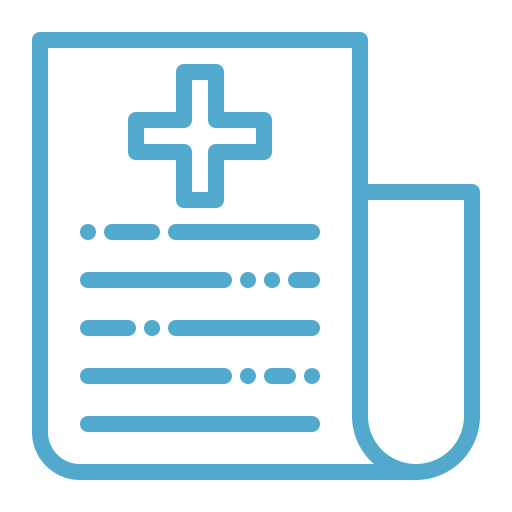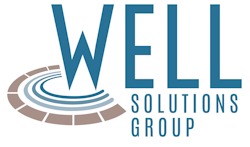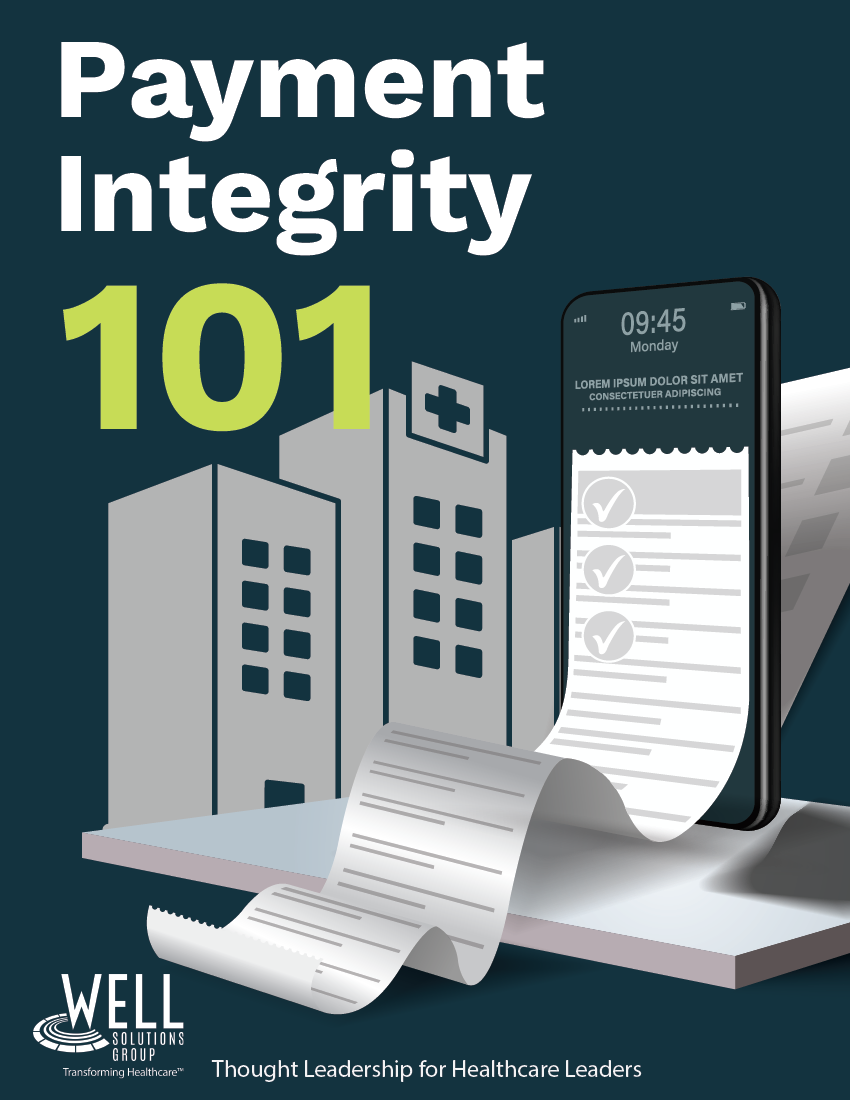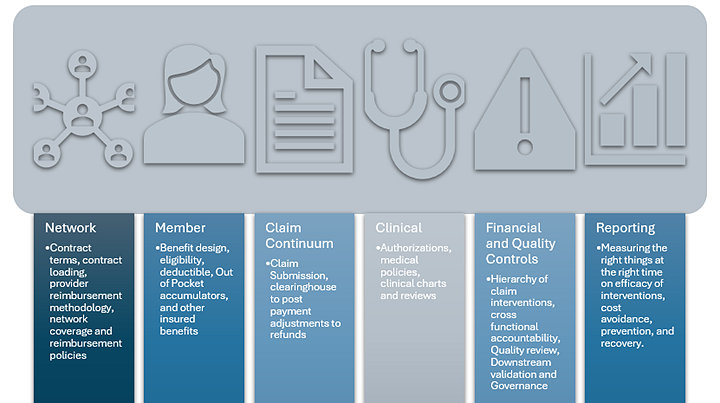Payment Integrity 101
May 2024
Well Solutions Group
Article 1: Current State of Healthcare
Payment Integrity
Payment integrity encompasses efforts by payers and healthcare providers to navigate ongoing challenges relative to achieving accurate and efficient payment. Having a system of payment integrity processes in place is essential for ensuring financial accuracy, maintaining compliance with regulators, optimizing the overall healthcare delivery system, and removing administrative waste, which can have a negative impact on patient care and quality outcomes.
billion DOLLARS in improper payments in fiscal year 2023
%
medical claims paid incorrectly each year.
%
of payers have 20% or more of claims needing rework
What does healthcare payment integrity entail, and why is there renewed interest?
At Well Solutions Group, among our clients, we have seen renewed interest in payment integrity. It is driven by increased medical expenses and the pent-up demand for patient health services access and care delayed during the COVID-19 pandemic. Health care utilization rates were uncharacteristically low during the pandemic, and slow to resume. As a result, health plans and other payers showed less interest in payment and cost-reduction strategies.
In this new world order, the healthcare industry is acutely focused on medical expense management, with payment integrity efforts at the forefront once again. Payers and providers are also discovering that the benefits of payment integrity can extend beyond cost savings and compliance. There is growing recognition that by embracing payment integrity initiatives, a more efficient, transparent, and sustainable healthcare system can be better achieved. By implementing robust processes and technologies to validate healthcare billing and reimbursement, payers can build credibility and foster stronger relationships with providers.
Efficient payment processes and accurate reimbursement also contribute to provider and patient (member) satisfaction by reducing administrative burdens and streamlining operations across the board.
![bill illustration Converted]](https://wellsolutionsgroup.com/wp-content/uploads/2024/11/bill-illustration-Converted.png)
By embracing payment integrity initiatives, a more efficient, transparent, and sustainable healthcare system can be better achieved..”

What is Payment Integrity?
Healthcare payment integrity at its core refers to the accuracy, efficiency, and compliance of the payment process. It encompasses the various activities and strategies across the healthcare financial transactions ecosystem aimed at preventing fraud, waste, and abuse, as well as addressing billing errors and inefficient claim processing. Achieving payment integrity involves implementing measures to validate the accuracy of the claims, detect fraudulent activities and ensure appropriate reimbursement. It is a collaborative effort involving payers, healthcare providers and other stakeholders.
The primary goal of payment integrity programs is to ensure honest claims are paid accurately. This includes claim adjudication and payment, considering factors such as payment responsibility, identifying potential errors related to benefits eligibility, benefits coordination, billing accuracy (including coding errors and mistakes), and cases of fraud, waste, and abuse. Increasingly, however, efforts are also focused on making sure claims are paid in accordance with the contract between payer and provider of care – that is, services are paid at the contractually indicated price.
High-level overview of Payment Integrity Scope
Often, organizations are not aware of the full breadth and depth of what Payment Integrity encompasses. The scope spans across the entire claim ecosystem. It includes efforts related to all aspects of paying claims, from direct payment of the claim itself to all the supporting documentation related to determination of who is responsible for making payment.
Examples of areas within the Claims Ecosystem that impact medical cost leakage risk:
Payment Integrity features both pre-payment and post-payment strategies. It encompasses the entire reimbursement process to ensure appropriate payment of services. Pre-payment capabilities seek to proactively identify and correct billing and claim adjudication errors before a health plan or payer disburses provider payment. Post-payment capabilities identify and resolve payment errors after the disbursement of the initial payment. It is essential to look for payment accuracy before and after payment to minimize medical cost leakage.
“Efforts are also focused on making sure claims are paid in accordance with the contract between payer and provider of care.”
![bill illustration Converted]](https://wellsolutionsgroup.com/wp-content/uploads/2024/11/bill-illustration-Converted.png)
Payment Integrity Key Levers
What follows is a high-level overview of the key Levers:
- Claim and Clinical Editing:
Address billing errors and inaccurate claims through a rules engine within the adjudication process. to align the claim with industry and line of business-specific logic to identify and, where appropriate, adjust claims for payment accuracy. - Custom Rules and Flags:
Specific claim system limits, unique or complex contract language, or benefit designs create risk for overpayments specific to the payer. Developing and applying custom methodologies for these scenarios is essential. - Coordination of Benefits (COB):
COB is a lever to share medical cost if the member has another health insurance benefit. COB addresses which insuring parties are responsible for what payments. This comes into play primarily between commercial insurance and government-sponsored plans (Medicare and Medicaid, for example). - Fraud, Waste and Abuse (FWA):
Fraud, waste, and abuse are forms of overpayment that range from performing and billing unnecessary or excessive services to not providing services and billing. These activities can have a detrimental impact on payers and lead to significant financial losses. Payers can employ various strategies to address these issues, such as implementing advanced data analytics and predictive modeling to identify suspicious patterns and anomalies in claim data. Claims are then tagged for prospective and retrospective review.There is also a prevention component that relies on the outcome of predictive modeling to identify areas that are more vulnerable to abuse and fraud, in particular. Medical chart reviews are also commonly used for much of the payment integrity work to confirm the validity of the billed claim.
- Subrogation:
The basic premise here is that one party (typically an insurer or a guarantor) makes a payment on an obligation, which by law is the primary responsibility of another party. In this case, the entity making the payment is subrogated to the claims of the entity for whom they made the payment. An example is that medical costs from a car accident are shared with the auto insurance company. - Premium Audit:
Premium Audits ensure accurate payment by leveraging additional materials besides the claim submitted. This includes itemized bills, medical charts to substantiate the level of care delivered, etc. Typically leveraged for complex claims, high dollars, and general known issues for claims with similar characteristics. - Overpayment Data Mining:
Another challenge in achieving payment integrity is the occurrence of billing errors and inaccurate claims further in the adjudication process and not caught before the payment is disbursed. Post-payment review for payment accuracy involves deploying algorithms to identify claims paid inaccurately due to correct coding issues, contract loading errors, compliance, and adherence to reimbursement policies. All post-payment negotiation, settlement, and recovering aspects of payment integrity are included. - Recovery:
Identifying overpayments is only one part of the post-payment integrity process. Resolving the payment error is required. There are two primary levers typically used to resolve overpayment. Both require notification to the provider. One is to “offset” (or down-adjust) future claims from the provider. Some state and contractual limitations may affect the ability to deploy this lever to recover the overpayment. Another method is requesting an overpayment be repaid by the provider.

Payment Integrity Definition
Payment integrity is the process of ensuring that healthcare claims are paid accurately and appropriately:
Payment integrity includes:
- Determining the correct party
- Checking membership eligibility
- Ensuring contractual adherence
- Detecting and preventing fraud, waste, and abuse
- Addressing unnecessary medical expenses
“MA plans are required to use rebate dollars to reduce cost sharing and/or premiums or provide extra benefits.”
Payment Integrity Enablers
There are several additional payment integrity levers that, when applied as an adjunct to payment integrity processes across the various components, lead to better success at achieving goals. These include the following:
- Well-documented reimbursement policies – Inclusive of coding methodology, industry-standard logic, and regulatory requirements. Reimbursement policies are generally based on national reimbursement determinations, along with state government program requirements.
- Contract negotiation support – Assistance in contract negotiation to ensure payment integrity techniques and recovery rules can be established in line with the final contractual determination of what services, what level of payments, and who is responsible (not limited to the actual claim payment itself). If the final negotiated contract is not clear and precise on those terms, it can lead to incorrect payments and disputes down the line.
- Prior Authorization – Putting in place prior authorization (approval) requirements by which physicians and other healthcare providers must obtain advance approval before a specific service is delivered to the patient to qualify for benefit coverage and payment.
- Risk adjustment for Medicare and other capitated risk contracts – Capitation is a payment arrangement for healthcare services that pays a physician or other contracted entity a set amount for each enrolled person assigned to them per a specified period, regardless of whether that person seeks care.
Actual claims are submitted for people assigned (attributed) to risk-bearing entities throughout the contract period and then aggregated at the end. This allows a review of how the “per member per month” capitated rate of payment compares to the otherwise expected cost for attributed members. Careful record-keeping and audit processes related to the level and cost of services delivered are critical in assessing the financial outcome (for both payer and provider) for the capitated arrangement.

Actual claims are submitted for people assigned (attributed) to risk-bearing entities throughout the contract period and then aggregated at the end. This allows a review of how the “per member per month” capitated rate of payment compares to the otherwise expected cost for attributed members. Careful record-keeping and audit processes related to the level and cost of services delivered are critical in assessing the financial outcome (for both payer and provider) for the capitated arrangement.

Prior Authorization Trends
- Increased requests
The number of prior authorization requests is rising — 46.2 million in 2022 - Complex process
More time-consuming steps and stricter documentation requirements. - Negative impact on patients
In one survey, nearly a quarter of physicians reported that prior authorization led to a serious adverse event. - Increased costs
The administrative costs of prior authorization are high, and can be passed on to patients. - AI-powered automation
AI and machine learning can help providers predict approvals and detect issues early. - Reform
The American Medical Association (AMA) is working on reforms for prior authorization.


